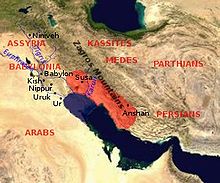Elamites
 |
|
| Alternative names | Elamites, Susiana |
|---|---|
| Geographical range | Iran |
| Period | Pre-Iranic |
| Dates | 2700 – 539 BC |
| Preceded by | Proto-Elamite |
| Followed by | Achaemenid Empire |
Elam (/ˈiːləm/) was an ancient Pre-Iranian civilization centered in the far West and Southwest of what is now modern-day Iran, stretching from the lowlands of what is now Khuzestan and Ilam Province as well as a small part of southern Iraq. The modern name Elam stems from the Sumerian transliteration elam(a), along with the later Akkadian elamtu, and the Elamite haltamti. Elamite states were among the leading political forces of the Ancient Near East. In classical literature, Elam was also known as Susiana, which is a name derived from its capital, Susa.
Elam was part of the early urbanization during the Chalcolithic period (Copper Age). The emergence of written records from around 3000 BC also parallels Sumerian history, where slightly earlier records have been found. In the Old Elamite period (Middle Bronze Age), Elam consisted of kingdoms on the Iranian plateau, centered in Anshan, and from the mid-2nd millennium BC, it was centered in Susa in the Khuzestan lowlands. Its culture played a crucial role during the Persian Achaemenid dynasty that succeeded Elam, when the Elamite language remained among those in official use. Elamite is generally accepted to be a language isolate unrelated to the much later arriving Persian and Iranic languages.In accordance to geographical and archaeological matching, historians argue that the Elamites were the Proto-Lurs, whose language became Iranian only in the middle ages.
...
Wikipedia
